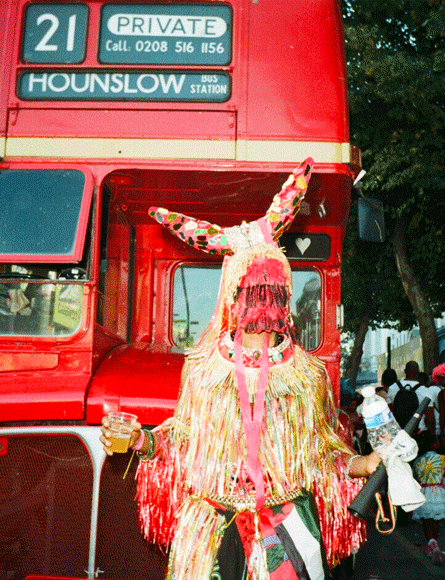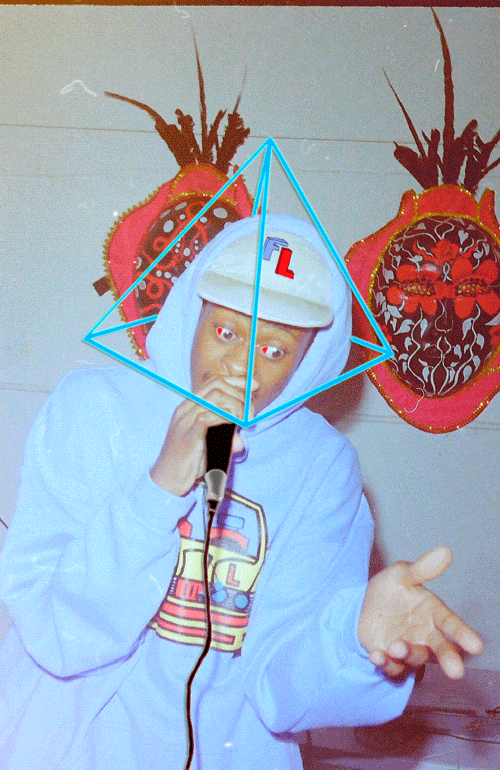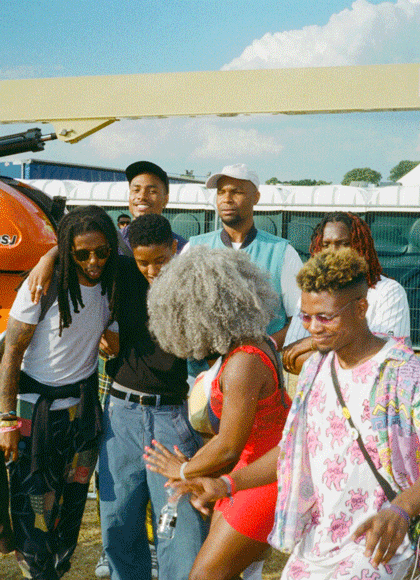Richie Mafwa is a self-proclaimed ‘jack-of-all-trades’, intent on delving deep into the creative world. A portfolio that documents artists and the music scene, he has also applied his talents in photography, videography, and poetry, to working with Adidas, JD Sports, Hunger Magazine, and Savage x Fenty. This year Mafwa demonstrated his design abilities as a guest designer for Nike, and maximised the opportunity to highlight Black Lives Matter. His high quality portraits that he transforms into GIFs, which include artist Rihanna, are fundamental to his practice, and a testament to his desire to explore his creative potential. Whilst GIFs aren’t traditionally considered an art form, Mafwa is validating that they can be used to create dynamic portraits of people, places and events. I spoke with Richie to discuss his journey from digital to analogue, documenting live music events, and his process as a guest designer for Nike.
NAHUEL CONTRERAS How did you get into photography? The preservation and proliferation of analogue photography continues to propagate. Have you always shot on 35mm film? RICHIE MAFWA I started by taking pictures digitally for memories (in 2012), and then I started film photography (35mm) because I wanted to touch into a different field. NC When you’re looking at a photograph, what engages you? RM What engages me about film photography is that it is one shot, if you miss, that’s it. It holds memories for a lifetime.
 NC
Who or what are your artistic influences? Have you always had a natural affinity for music?
RM
I’ve always been my own artistic influence. I’ve always loved music but I’ve tried to stay in my own lane.
NC
When documenting social scenes such as festivals and live music events, what elements are you looking to capture? Is narrative important within your work?
RM
When in action on the live music scene, I like to capture what has energy, or what could always be looked at over and over again.
NC
Is the process of capturing a personality spontaneous, or do you construct how you want them to pose?
RM
At live events it’s spontaneous 80% of the time, unless I get to talk to the artist.
NC
Who or what are your artistic influences? Have you always had a natural affinity for music?
RM
I’ve always been my own artistic influence. I’ve always loved music but I’ve tried to stay in my own lane.
NC
When documenting social scenes such as festivals and live music events, what elements are you looking to capture? Is narrative important within your work?
RM
When in action on the live music scene, I like to capture what has energy, or what could always be looked at over and over again.
NC
Is the process of capturing a personality spontaneous, or do you construct how you want them to pose?
RM
At live events it’s spontaneous 80% of the time, unless I get to talk to the artist.
 NC
Do you try to establish a relationship with your subjects as a prerequisite to shooting?
RM
I always establish a relationship with my artists as much as I can because I love natural energy, and I like the shoot to feel free.
NC
The way you transform your photography shot on film into animated looping 3D GIFs is quite distinctive. What do you find most exciting about working with GIFs, and combining analogue and digital technology?
RM
What I find exciting about GIFs is the infinite loop of the moment; it’s the only time you get to see that moment captured with one take.
NC
Do you try to establish a relationship with your subjects as a prerequisite to shooting?
RM
I always establish a relationship with my artists as much as I can because I love natural energy, and I like the shoot to feel free.
NC
The way you transform your photography shot on film into animated looping 3D GIFs is quite distinctive. What do you find most exciting about working with GIFs, and combining analogue and digital technology?
RM
What I find exciting about GIFs is the infinite loop of the moment; it’s the only time you get to see that moment captured with one take.
 NC
I understand you also write poetry. Thinking about the possibility of photography and the ability to not only document but also offer a fantasy, do you ever utilise poetry as a reference point for your visual work?
RM
I’m going to be utilising poetry and my visuals as reference points more soon, but at the moment I have kept them separate.
NC
You mentioned that you are currently directing music videos, how do you bring your artistry as a photographer into this new visual form?
RM
I’ve always had a keen eye and the ability to focus on multiple things at once. I wouldn’t call myself a photographer, but a jack-of-all-trades; I see everything as connecting the dots, so it has been a smooth transition.
NC
This year you this year you released a shoe with Nike as a guest designer. Can you tell me more about this?
RM
When I was selected by Nike to be a guest designer for shoes I couldn’t focus my mind away from the current situations that were happening around the time period. Luckily, Nike allowed me to spread my awareness and message in my own form.
NC
I understand your intent for this this collaborative opportunity was to highlight Black Lives Matter, how did you articulate this?
RM
As a Black creative, I tried to spread awareness by just being me, and showing that this is how it’s supposed to be- one small droplet at a time, not being too triggering, and showing that Black people can be excellent.
NC
“Red waves rippling to the core like train links to central London” is how you partly describe the colour palette; tell me more about this creative process?
NC
I understand you also write poetry. Thinking about the possibility of photography and the ability to not only document but also offer a fantasy, do you ever utilise poetry as a reference point for your visual work?
RM
I’m going to be utilising poetry and my visuals as reference points more soon, but at the moment I have kept them separate.
NC
You mentioned that you are currently directing music videos, how do you bring your artistry as a photographer into this new visual form?
RM
I’ve always had a keen eye and the ability to focus on multiple things at once. I wouldn’t call myself a photographer, but a jack-of-all-trades; I see everything as connecting the dots, so it has been a smooth transition.
NC
This year you this year you released a shoe with Nike as a guest designer. Can you tell me more about this?
RM
When I was selected by Nike to be a guest designer for shoes I couldn’t focus my mind away from the current situations that were happening around the time period. Luckily, Nike allowed me to spread my awareness and message in my own form.
NC
I understand your intent for this this collaborative opportunity was to highlight Black Lives Matter, how did you articulate this?
RM
As a Black creative, I tried to spread awareness by just being me, and showing that this is how it’s supposed to be- one small droplet at a time, not being too triggering, and showing that Black people can be excellent.
NC
“Red waves rippling to the core like train links to central London” is how you partly describe the colour palette; tell me more about this creative process?
 RM
With this process I thought about my home, which is London and Africa, and (the proverb) home is where the heart is. The main link to London, and the heart of London, is Central London, so I came up with the idea of red representing Africa as a colour, and (as a reference to) the central line.
NC
As Black artists, creating a perspective of visual resistance runs parallel to societal and systemic issues. Is your creative practice a way to explore and express your own identity and experiences? If so, how?
RM
Yes, my creative practice is a way to express this, one small step at a time. Due to big companies not spreading triggering awareness, I had to find a way to tackle it lightly so that people get it, because we have to start small for them to realise that they care.
NC
What does the future hold for you?
RM
Everything
RM
With this process I thought about my home, which is London and Africa, and (the proverb) home is where the heart is. The main link to London, and the heart of London, is Central London, so I came up with the idea of red representing Africa as a colour, and (as a reference to) the central line.
NC
As Black artists, creating a perspective of visual resistance runs parallel to societal and systemic issues. Is your creative practice a way to explore and express your own identity and experiences? If so, how?
RM
Yes, my creative practice is a way to express this, one small step at a time. Due to big companies not spreading triggering awareness, I had to find a way to tackle it lightly so that people get it, because we have to start small for them to realise that they care.
NC
What does the future hold for you?
RM
Everything
